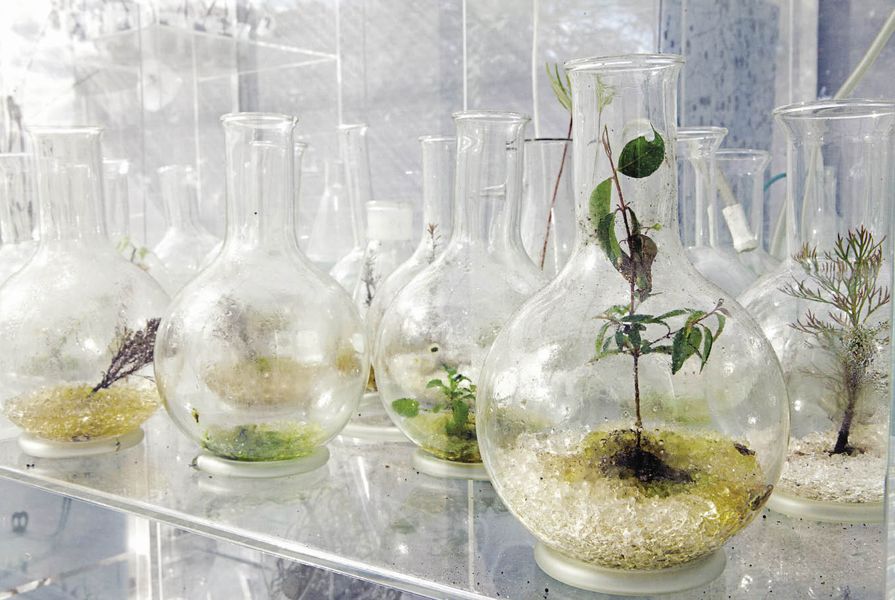One of the most engaging contributions to the recent Biennale of Sydney could be found in a quiet corner of the Botanic Gardens. Here Janet Laurence created Waiting – A Medicinal Garden for Ailing Plants, a site-specific installation that drew attention to the fragile state of the environment.
This evocative piece continued the artist’s previous investigations into the overlapping realms of science and nature through the concept of a medicinal garden. “I decided to make this garden that brought our attention to caring and healing, and at the same time created an empathy with the plight of plants,” Laurence explains.
The boxes resemble wards in a hospital.
Image: Jamie North
While people have traditionally cultivated medicinal gardens for the treatment of human ailments, here it was the plants that required medical assistance from us. Drawing on the architecture of neighbouring glasshouse structures, the installation took the form of a hospital tent clad in white garden mesh.
Laurence sought to create an immersive experience that directly engaged the viewer. On stepping inside, the unassuming exterior gave way to an elaborately detailed interior. The installation was conceived as a kind of “wunderkammer,” a cabinet of curiosities for the collection and display of scientific oddities. Located in the centre of the room, a stacked grid of glass boxes housed an extensive array of botanical specimens, medical paraphernalia and laboratory equipment.
In creating these glass displays Laurence paid homage to the alchemical vitrines of influential German artist Joseph Beuys. Viewed by many as the father of the environmental art movement, Beuys was motivated by a firm belief in the ability of art to effect change in society. Through his elegantly simple vitrines, Beuys sought to initiate a process of healing in society. Each vitrine consisted of an old museum display case containing everyday objects symbolizing the transformation of energy and healing.
Waiting – A Medicinal Garden for Ailing Plants drew attention to the need for healing within the natural environment. Echoing the structure of wards in a hospital, each box was assigned a medicinal specialty based on the physiology of a plant. At one end of the grid, hundreds of green-tinted glass vials represented the Chlorophyll Production Unit. The Fertilization Area resembled an IVF unit, with tiny seeds cradled in shallow Petri dishes. In the Intensive Care Unit plants appeared to be recuperating in miniature acrylic beds.
Fragile branches are covered in bandages and gauze.
Image: Jamie North
A subtle playfulness infused much of the work, allowing it to convey its message of environmental awareness in a way that was at once alarming and endearing. Charred branches lay beside pools of water in the Hydrology Department, while a large branch swathed in bandages dominated the Casualty Unit. The life cycle came full circle in the Morgue, where the ashen remains of leaves lay frozen within rectangular glass trays.
Laurence worked closely with horticulturalist Michael McNaught from Eden Gardens nurseries to ensure living plants were incorporated into the work with tenderness and respect. Slender green shoots grew inside elongated test tubes suspended from the ceiling, and were intravenously watered through coiled loops of plastic tubing. Larger specimens were enshrouded in ethereal clouds of fine gauze to prevent spores escaping into the surrounding gardens. Young plants were housed in protective glass vials, their fragile roots supported on soft gel beds. Over the course of the biennale the gel crystals took on vibrant hues of yellow, pink and green as the crystals absorbed the natural dyes of the plants.
A transparent mesh structure encases the scientific vitrine.
Image: Jamie North
Against a clinical palette of white mesh, glass, plastic tubing and mirrored surfaces, the sparing use of pink and green drew immediate parallels between the human and botanical worlds. This was clearly demonstrated in the Homeopathy Unit, where healthy green specimens were paired with dying plants, their withered leaves painted pale pink to accentuate the vulnerability of their condition. “I used the colour pink because I quite liked the association with us and our medicine,” Laurence explains.
The notion that all living things are connected is a common thread in the diverse work of Janet Laurence. For the 2005 Echigo-Tsumari Art Triennial she created an elixir bar inside an abandoned Japanese farmhouse. Elixir explored the relationship between the local community and traditional medicinal plants, with vials of herbs steeped in shochu lining the bar. Visitors were offered shots of these elixirs in beakers served by local people dressed in white laboratory coats. Located in a remote rural prefecture, this permanent installation embodies Laurence’s belief in the ability of art to transform society, with the elderly inhabitants “given new roles as custodians of the artworks.”
In a similar way, Waiting – A Medicinal Garden for Ailing Plants drew attention to our role as caretakers of the natural environment. With its emphasis on nurture and healing, the installation invoked the need for urgent environmental action without accusation. “There is also something sad about it as well,” notes Laurence, “which is that we can’t do it without the intervention of science anymore.”
Source

Discussion
Published online: 3 Feb 2012
Words:
Natalie Ward
Images:
Jamie North
Issue
Landscape Architecture Australia, February 2011






















